Disinformation
Infosecurity.sk: Bi-Weekly Report on Emerging Disinformation Trends (July 1, 2021)

Project Infosecurity.sk organised by STRATPOL – Strategic Policy Institute and Slovak Security Policy Institute, supported by the Prague office of Friedrich Naumann Foundation for Freedom, continuously monitors the activities of both Slovak and foreign disinformation actors but focuses mainly on the former. The project activities are built upon daily monitoring of emerging disinformation, hoaxes, and conspiracy theories in the online information space. That allows the analysts to identify disinformation posts and narratives that resonated with the public the most, as well as to find out where they originated, and how they spread and evolved on social media. This report represents a bi-weekly summary of arising trends in the spread of malicious information content online. Based on that, Infosecurity.sk can warn the public about emerging and current trends in the field of disinformation, manipulation, and propaganda.
With the first half of 2021 almost over, this week Infosecurity.sk presents not only an overview of the disinformation trends it has been able to capture over the past two weeks, but also a semi-annual overview of how successful disinformation actors have been on social media in the first half of 2021:
1. In the last 6 months, disinformation actors have been relatively successful when it comes to strengthening their position on social media and garnering a lot of public attention.
2. Over the past six months, the disinformation media has spread false narratives on a variety of topics; according to the analytical tool CrowdTangle[1] those that resonated with the audience the most were related to the ongoing Covid-19 pandemic.
3. While the number of interactions of some "alternative" media showed a declining trend over the last six months, other disinformation actors, some of them belonging even among Slovak politicians, have consolidated and strengthened their position by gaining new followers on their Facebook pages where they spread disinformation and other harmful content.
4. The disinformation actors gain attention primarily through spreading content instigating feelings of fear and uncertainty. With experts´ warnings related to a possible third wave of the Covid-19 pandemic caused by the more infectious Delta variant of the virus, the disinformation actors are wasting no time in capitalising on the renewed sense of crisis.
5. Over the past two weeks, a new wave of posts has popped up on social media with the same old anti-vax and anti-pandemic measures narratives regarding the Delta variant.
A look back at the first half of 2021: how successful have the disinformation actors been on Facebook?
As 2021 slowly enters its second half, it is time to assess the semi-annual activities of the local disinformation actors. As society faced the second wave of the unprecedented Covid-19 crisis, it can be said that the first half of 2021 was a fruitful year for Slovak disinformation actors. Fear, uncertainty, and general fatigue of pandemic measures, coupled with sensitive topics such as vaccination have given disinformation actors ample opportunities to inject the information flow with their false narratives.
We will first take a look at the leading local disinformation media. For the comparison, we selected three most popular disinformation websites in Slovakia: Hlavné správy, Hlavný denník and ExtraPlus. With the help of the analytical tool Crowdtangle, we have prepared a series of graphs illustrating the activities and possible impact of these disinformation actors on social media, particularly Facebook, in the past 6 months in terms of published post counts and total interactions (comments, shares and reactions).
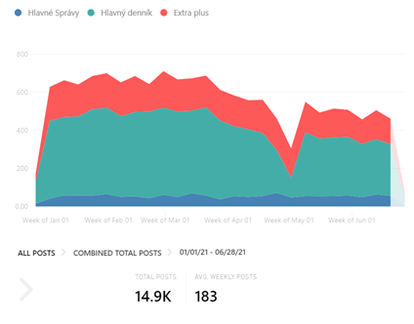
The graph above shows that the selected disinformation media have published almost 15,000 posts on Facebook since the beginning of the year, an average of about 183 posts per week. We can also observe that the disinformation media remained relatively stable in publishing of their content during the observed period. The total number of posts and the weekly average of published posts are comparable to the figures of the leading credible media in the country: Aktuality.sk, SME and Denník N, whose statistics are presented in the following graph.
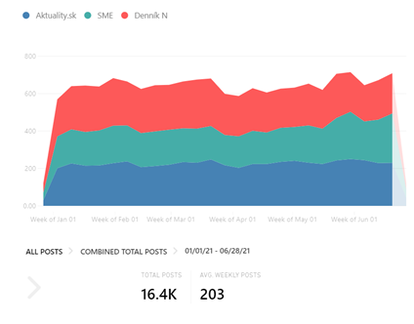
One area where disinformation media and credible media differ significantly is the number of interactions. The two graphs below show the number of interactions gained in the first half of 2021.
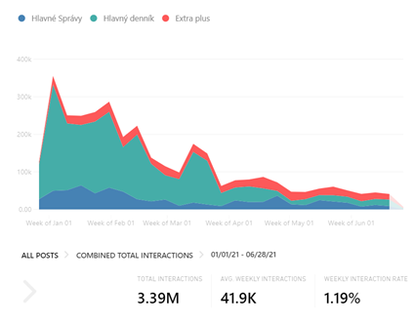
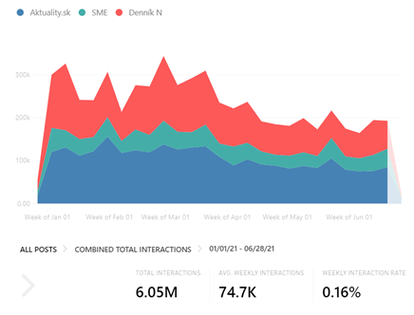
As the first graph above shows, the disinformation media gained more than 3 million interactions related to their posts. Nevertheless, we can also observe a declining number of interactions for the disinformation media, particularly from April onwards, while for the credible media the number of interactions has remained relatively stable over the observed period, as illustrated in the second graph.
It is no surprise that the disinformation media primarily capitalise on political crises and polarising issues, of which the first half of 2021 offered many. Over the past six months, the disinformation media have spread false narratives on a variety of topics; according to CrowdTangle those that resonated with the audience the most were related to the ongoing Covid-19 pandemic. The beginning of 2021 was marked by the second wave of the Covid-19 pandemic and the strict pandemic measures that accompanied it. These coupled with other polarising issues such as vaccination provided ample material for the disinformation media to thrive on.
As highlighted in our previous bi-weekly monitoring reports, the disinformation media sought to downplay the severity of the pandemic and discourage the public from getting vaccinated with Western-made vaccines by overemphasising rare cases of adverse side effects. The Slovak government's purchase of the unregistered Russian vaccine Sputnik V proved as a particularly polarising topic in the Slovak society, bringing with it a domestic political crisis and a new wave of disinformation narratives. In this respect, the conditions in the first quarter of 2021 proved favourable for the disinformation media.
Nonetheless, as 2021 entered its second quarter, the number of total interactions reached by the disinformation media began to dwindle. This trend can be attributed to a combination of various factors. One explanation could be that the combined efforts of many NGOs in debunking various false narratives, as well as government-sponsored pro-vaccination campaigns, contributed to undermining the strength of the disinformation media. Another explanation could be that the "novelty" of the disinformation narratives simply diminished over time.
Although the gradual decline in the total number of interactions of disinformation media is positive news for Slovak information security, it does not mean that the disinformation actors no longer pose a serious threat. The steady number of newly published posts shows that the Slovak disinformation media continue to flood the information space with their false narratives while still receiving high attention from the public – roughly 100 000 interactions in the past 2 weeks alone.
Furthermore, if we take a closer look at other disinformation actors besides "alternative" media, we can observe an opposite trend. For comparison, we have selected three Slovak opposition politicians who are known for spreading harmful content on their personal Facebook pages and whose disinformation posts figured prominently in our previous bi-weekly monitoring reports in terms of popularity. These are the personal pages of Luboš Blaha, a Slovak far left MP known for spreading a plethora of problematic content, and the pages of two former members of the far-right Kotleba - People's Party Our Slovakia, Milan Mazurek and Milan Uhrík, who recently founded their own party Republika.
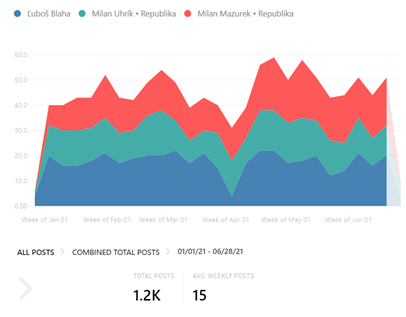
As illustrated by the graph above, the three politicians combined have only published about 1,200 posts since the beginning of the year. Despite a relatively low number of posts, they have collectively reached over 9 million interactions, which have remained stably distributed over the observed period as illustrated in the graph below.
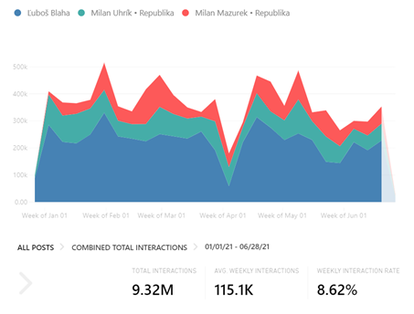
Furthermore, if we look at the following graph illustrating the increase in the number of their followers over the last 6 months, we can see that together they have gained over 80,000 new followers on their Facebook pages - a growth of almost 30%. Therefore, while the "alternative" media declined in terms of interactions since the beginning of the year, these disinformation actors were able to consolidate and strengthen their position. One possible explanation for this phenomenon is that, whereas in the past the main source of the various conspiracy and disinformation narratives was the "alternative" media, in recent years these narratives have gradually found their way into the rhetoric of mainstream politicians. Thus, politicians are becoming the primary sources of such content - gradually overshadowing the "alternative" media.
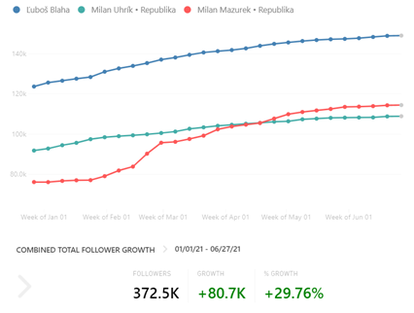
It is important to stress that the disinformation actors selected for the comparison and Facebook statistics overall reflect only a small portion of the ongoing disinformation campaigns. We are fully aware that such statistics alone cannot comprehensively explain the real impact of disinformation actors. However, they still provide us with valuable insights on general disinformation trends and potential reach of disinformation actors.
New opportunities for the disinformation actors on the horizon?
The disinformation actors feed on feelings of fear and uncertainty. As experts warn of a possible third wave of the Covid-19 pandemic caused by the more infectious delta variant of the virus, the disinformation actors are wasting no time in capitalising on the renewed sense of uncertainty.
A new wave of posts with the same old anti-vax and anti-pandemic measures narratives popped up on social media in the past two weeks. The majority, as usual, attempted to appeal to negative emotions of the public and create the impression that one loses its freedom by getting vaccinated. Some disinformation actors called the government the "vaccination Gestapo" and the Delta variant a pretext to keep the population in a perpetual state of restrictive measures.
We can observe that the disinformation media continue to use the same old tropes repeatedly, slightly adapting them to current developments. This can also be seen in the way the disinformation media uses developments in the sports world, particularly the European Football Championship, which is currently a hot topic in Slovakia, and which unfortunately has been used as a springboard to spread harmful content.
Firstly, in relation to the recent collapse of the Danish football player Christian Eriksen on the pitch, the disinformation actors quickly linked this tragic event to side effects of vaccination against Covid-19. However, the spokesman for Danish Football Federation refuted the information, as the cause of Eriksen's collapse was in fact cardiac arrest. Secondly, the disinformation actors also attempted to capitalise on the controversy surrounding the plans to light up the Munich Allianz Arena in rainbow colours during the Germanys match against Hungary - a reaction to Hungary's discriminatory anti-homosexual law passed recently. In this regard, the local disinformation media used the opportunity to advance their anti-Western and anti-EU narratives, portraying Orbán as a hero defending his country's values despite the pressure from the EU.
In general, during the previous 6 months the disinformation actors were able to strengthen their position on social media and garner a great deal of public attention. With the third wave of the Covid-19 pandemic looming around the corner, and many more polarising issues on the way, it remains to be seen how disinformation actors will perform in the second half of 2021.
[1] CrowdTangle is a tool from Facebook to help follow, analyse, and report on what’s happening across social media. https://www.crowdtangle.com
Matej Spišák is a Research Fellow at STRATPOL – Strategic Policy Institute in Bratislava and Editor-in-Chief at Infosecurity.sk.
Denis Takács is an Analyst at STRATPOL – Strategic Policy Institute in Bratislava.

